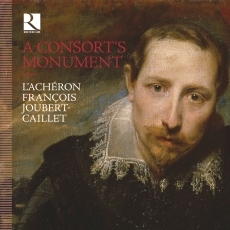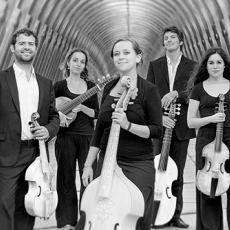L'Achéron - A Consort’s Monument - musica Dei donum
A monument is usually erected when the event to be commemorated has taken place, or the person to be honoured has deceased. Exactly that is the case with the theoretical work that was the inspiration for this recording: Musick's Monument, or A Remembrancer Of the Best Practical Musick, both Divine and Civil, that has ever been known, to have been in the World by Thomas Mace, which was published in 1676. It is a description of a musical world that had gone: the world we call 'Renaissance', which held its ground in England longer than anywhere else. The admiration with which Mace describes the glorious past, is also a token of his scepticism towards the latest musical developments in the direction of what we call the 'Baroque', which received a strong boost after the Restoration of 1660. The court played a substantial role in this development, as Charles II, who had returned from exile in France, had become acquainted with the latest music written on the continent, which he preferred to the traditional English 'fancy', that he could not stand.
Mace's book comprises three parts. The first is devoted to the polyphony written for the liturgy of the Church of England, the second is about the lute, and the third discusses the viol ("The Generous Viol, in Its Rightest Use") and performance practice in general. The latter is given special attention by the performers. Some years ago Arnauld Giralt built a set of viols for the ensemble, the result of thorough research of the construction of English renaissance viols. François Joubert-Caillet, in his liner-notes, refers to passages in Mace's book, in which he recommends to play "on viols that are proportionate in size to each other". Mace also mentions what is the ideal consort of viols: two trebles, two tenors and two basses, which is also the line-up of L'Achéron in this recording.
It played this consort of viols in a previous recording, but for this project one aspect was added: the role of the keyboard. Mace specifically mentions that the organ is used as a "touch-stone", as it keeps the instruments in tune. He emphasizes that it should be clearly audible, especially to the performers. However, he judges that the organ is not always the most appropriate instrument, and that is where the harpsichord or the virginal comes in. The performers felt that the instruments mostly used in English renaissance music were not the most suitable, and in several ways different from what was common in England at the time. Although virginals from the continent, for instance by Flemish builders, were employed in England, "[the] English sound world of that time was highly discreet and has not yet been sufficiently explored, although it reveals individual and unique timbres that contrast strongly with what we know of the French, Italian and German schools of the time." For that reason, two instruments were built for this recording. In particular the virginal is very different from the instruments mostly used in recordings of music by the English virginalists. Interestingly, the builder of the virginal was at first not convinced about the result. However, he started to recognize that its sound was better suited to blend with the viols than the more common instruments.
The consort of viols is joined by the keyboard instruments in some of the pieces selected for this recording, and often they are not easily recognizeable. However, that seems to be exactly as it should be: they are at the service of the performers in the first place. Interestingly, the builder of the organ writes in the booklet that organs "were useful for the viol consorts, because the viol players were often gentlemen, who could engage a professional keyboard player to play their parts from a score, to regulate their contribution. These days the viol players are themselves professionals, and it is rare to hear viols 'to the organ' as one should". This seems in line with Mace's statement that the organ was used to keep the consort in tune.
The programme performed by L'Achéron is also inspired by Mace's book, as he mentions several of the best composers of consort music. It is remarkable that he does not mention some of the composers who in our time figure prominently in recordings of consort music, such as John Dowland and William Byrd. He rather mentions several who are today little-known and whose music is not that often performed and recorded. One of them is John Ward, who is known for his often stubborn and unusual harmonic language. The Fantasia VII is a good example. Even lesser known is William White, about whom virtually nothing is known. His extant oeuvre is rather small, and includes some anthems and a number of pieces for viol consort, which show that he was well versed in the art of counterpoint. His five- and six-part consort pieces were especially popular, if we go by the sources in which they have been preserved. The Fantasia II is a fine example of his output in this genre.
The programme mentions several composers with Italian names. Both Ferrabosco and Lupo were from families who were originally from Italy. Ferrabosco's father - known as Ferrabosco the elder or Ferrabosco I - divided his time between England and Italy. His son - Ferrabosco the younger or Ferrabosco II - played an important role in music life at the court. In the early 1590s, when he was probably not yet 20 years old, he already received an annuity as musitian of the violles from Queen Elizabeth. However, he probably did not play a major part in court performances, and only in 1602 he was given an official position. In the next years he acted as the teacher of Prince Henry, for whom he also bought viols. In 1605 The Masque of Blackness was performed, on a text by Ben Jonson, for which Ferrabosco wrote the music. It was the first of many contributions to the genre of the court masque. A number of songs, probably originally written for such masques, was published in 1609 as airs for one and two voices with lute and bass viol. Recently, I reviewed two discs with music for viol consort as well as pieces for the lyra viol.
Thomas Lupo was from a family of Italian Jews who came to England in the late 1530s. Thomas joined the court violin consort in 1588 at the age of only 16, and held this post until his death. In 1610 he also became a member of Prince Henry's household and in 1617 the household of Prince Charles, who was an avid viol player. He also acted as a patron to Ferrabosco II and to John (or Giovanni) Coprario. His consort music is strongly inspired by the Italian madrigal. Coprario was also under Italian influence. Although of English birth, he Italianised his name after having spent some time in Italy. It is not entirely clear whether O voi che sospirate was originally written as a madrigal, whose text has been lost, or was meant as an instrumental piece from the onset, modelled after the madrigal.
Apparently, Mace was very interested in Italian music. This explains why he also mentions Claudio Monteverdi, the only composer who never set a foot in England. He calles him a "Famous Italian Author". As we have seen, several composers were influenced by the Italian style, but it should be emphasized that the Italian influence was largely confined to music written in the stile antico, for instance madrigals by the likes of Luca Marenzio. The madrigal by Monteverdi included here is from his third book of madrigals of 1592, which is still firmly written in the old style.
The latest composers in the programme are John Jenkins and Christopher Simpson. Although the latter has left quite some music for viol consort, he has become best-known as the author of a treatise on the art of writing divisions on a ground bass. His pieces for solo viol are much better known than his consort music, and in them we find a level of virtuosity which was rather uncommon at the time in England. Jenkins, on his part, experienced the transition from the stile antico to the stile nuovo: in the latest stages of his life he composed music with basso continuo parts. In his consort music, he often suggests the violin as an alternative to the treble viol. He played the violin himself, but in early-17th-century England, this was still a consort rather than a solo instrument.
In order to demonstrate the features of the two keyboard instruments, Philippe Grisvard and Yoann Moulin add some improvisations, which is a nice bonus to this compelling programme of consort music, which receives a masterful performance from L'Achéron. This is a most interesting production, which greatly enhances our knowledge of a genre, which was one of the most important in the England of the first half of the 17th century, and in many ways so different from what was written elsewhere. That justifies the research which is the foundation of this project. The development of instruments which were a specialty of a particular country is of great importance in order to come closer to the nature of the music. The members of l'Achéron have done the music and the music lovers of our time a great favour.

